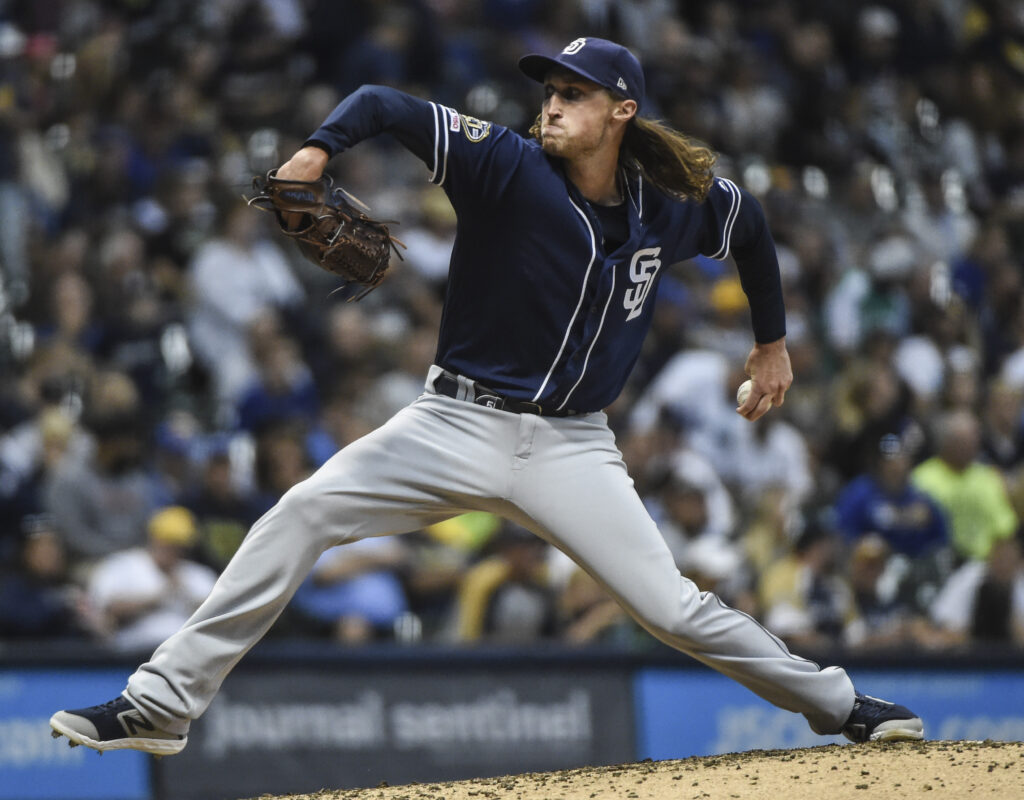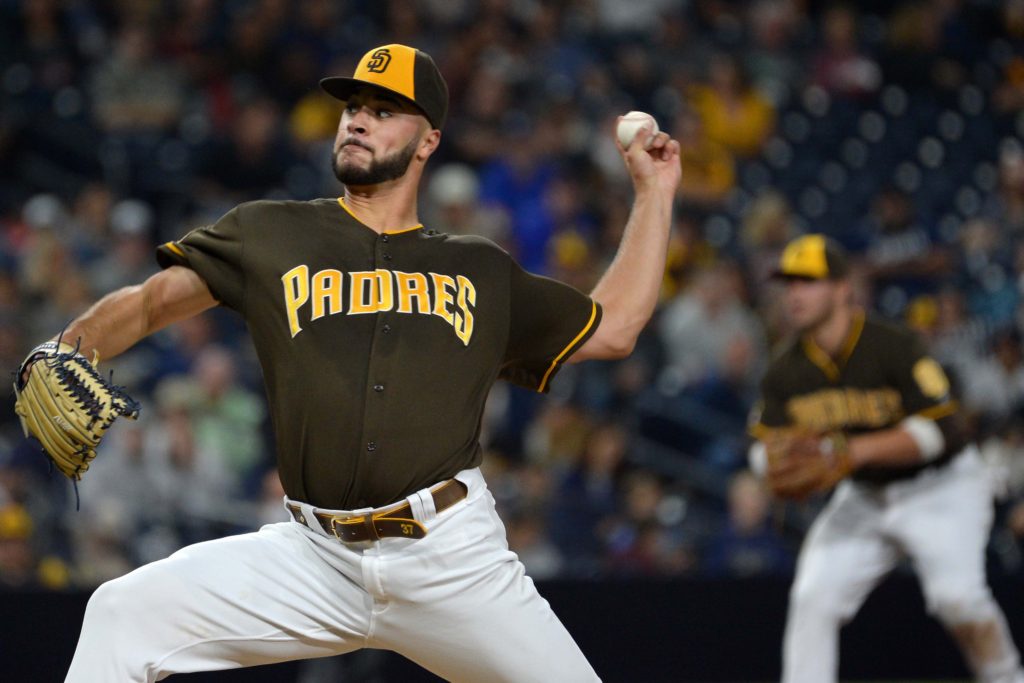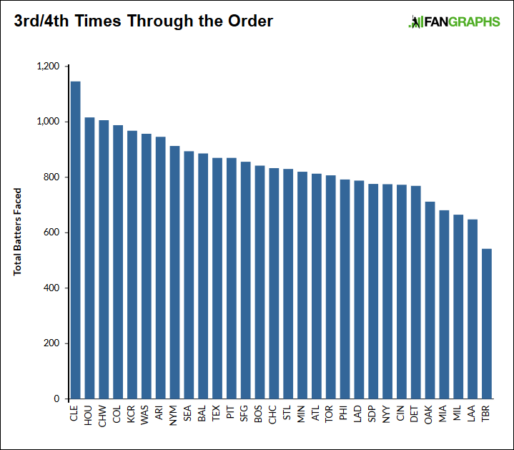Could the San Diego Padres benefit from using an opener?

Sep 17, 2019; Milwaukee, WI, USA; San Diego Padres pitcher Matt Strahm (55) throws a pitch in the sixth inning against the Milwaukee Brewers at Miller Park. Mandatory Credit: Benny Sieu-USA TODAY Sports

A look at how the Padres could use a unique strategy to get the most out of their pitching staff
It is no secret that the San Diego Padres have a deep bullpen, and with limited rotation depth, they may need to get creative to maximize the effectiveness of their pitching staff.
MLB teams are constantly looking for ways to gain even the smallest advantage over their opponents, often employing new strategies, and even revisiting some which have been used in the past. Such is the case with “the opener,” which has caught on over the past couple of seasons but was first employed by the 1993 Oakland Athletics before being brought back to life by the 2018 Tampa Bay Rays. In this piece, we’ll discuss how the opener works, and how the Padres could use this strategy to play to their strengths in 2020.
What is the purpose of an “opener”?
The opener concept is relatively simple. The idea is to limit a starting pitcher’s exposure to the opposing lineup for a third and fourth time. The more times a batter faces a pitcher during a game, the better the batter tends to perform, especially the third and fourth Time Through the Order (TTO). The numbers back this up, but it’s also relatively intuitive; by the time a pitcher is facing a lineup for the third time, and beyond, the batters have had multiple chances to get a feel for what the pitcher is doing, and the pitcher is likely impacted by fatigue to some degree. By limiting the TTO exposure of the “starting pitcher,” the degree to which the TTO penalty takes effect can be minimized. Essentially, it works like this:
- A reliever – typically with the best possible platoon advantage – is used to face the top of the opposing lineup for an inning (sometimes two innings).
- The “starter” then comes in and goes to work. By the time he would normally be facing the lineup for the third time, he’s only facing them for the second time.
- When the “starter” does get to the third TTO, he’s usually facing the bottom of the lineup, and presumably worse hitters than the top of the lineup. This helps to mitigate the TTO penalty.
Is this strategy effective?
In terms of limiting pitcher exposure to the TTO penalty, absolutely. According to Jeff Sullivan’s 2018 piece, the Rays were able to limit TTO penalties more than any other team in baseball by using an opener, as shown in his graph:

However, simply having faced less batters for a third time is only a good thing if you’re doing that on purpose, and not if it’s happening because your starters can’t make it out of the fourth inning, which was the case for many of the teams who were closest to the Rays in this category.
Now, the question of whether this strategy is an effective way to prevent runs is a bit more interesting. We can’t just say “Team X allowed less runs on average with an opener than most teams did without an opener, so it definitely works” because that doesn’t prove that Team X was allowing less runs specifically because of the opener. Another way to determine if a baseball strategy is effective is to see if other teams are buying into it (hint: they are). This doesn’t necessarily mean it’s the best possible strategy, but it does indicate that other teams see value in it. Perhaps the teams that are best positioned to benefit from this strategy are those which feature a strong bullpen and have at least a couple of very good starters that are effective enough that the TTO penalty doesn’t hurt them as much. Does that description remind you of any team in particular?
What would it look like if the Padres used an opener?
Using a reliever to start a game is not an unfamiliar concept for the Friars. Relievers have been used by the Padres to open games many times in the past, but this has usually occurred as a result of a “bullpen game” in which relievers are mixed and matched throughout the entire game.
The opener strategy isn’t necessarily as effective for frontline starters, who are often still above-average even after incurring the TTO penalty. An opener may be quite useful for a pitcher like Joey Lucchesi, though. Lucchesi is solid across the board but doesn’t necessarily have anything elite in his arsenal, which may allow hitters to adjust to him over the course of a game. His TTO splits back this up:

Lucchesi has been solid the first couple of times he’s faced opposing lineups, but he’s really struggled when facing hitters for the third time. This makes sense given that Lucchesi has three solid pitches, but only his changeup is considered to be a plus offering, and his command is good, but not elite. As you can see, Lucchesi has gotten absolutely destroyed when facing hitters for the third time in a game. It would be remiss not to mention that his sample size for the third TTO is roughly one-third of that for the first and second, but that’s also largely a result of being pulled early during the third TTO because he’s getting lit up by opponents.
The opener could be a useful option for Garret Richards, who may need to limit his workload early on given that he has less than nine big league innings under his belt since coming off Tommy John surgery and may need to knock some rust off before (hopefully) returning to his previous form. The Padres have a have a handful of young pitchers that could see MLB innings this season, and using an opener could help to keep innings counts down a bit.
It’s not yet clear how Jayce Tingler intends to utilize his pitching staff. Still, one thing is certain: if the Padres decide the opener may be an effective strategy for their club, they have enough bullpen depth to do it without hurting themselves in the late innings.
All Stats used in this article are courtesy of Fangraphs unless otherwise noted.
Holden Phillips is an Occupational Exposure Scientist who also happens to write about baseball, primarily focusing on analytics. He is a huge baseball fan and fell in love with the Padres during his college years when West Coast baseball was often the only baseball on TV after 9pm in the Eastern time zone. Find his work at eastvillagetimes.com and maxsportingstudio.com.
Good article.
You make an excellent point about Lucchesi pretty much getting destroyed the 3rd time through the order, or in the 5th inning. This happened constantly last year, that starting pitchers were left in to get hammered in the 5th inning, while the manager sat there looking lost. If Tingler makes this one change the team’s record should improve by a minimum of 5 wins.
It will be interesting to see how Tingler will handle this young staff. We will have many pitchers on limited innings. Whether due to recovery or caution, it can be a sound strategy. I’d rather not be coming from behind more games than not. If using a RP followed by a SP makes the number 5 rotation spot more effective, why wouldn’t we? If it equates to a possible extra 3-5 wins a season, why wouldn’t we? We bring in player X hoping to gain WAR and other stats, thus making us more competitive. Why would we not utilize other methods to increase our chances to win?
The downside could be burning up our bullpen and not have them available when needed as #3 rotation pitcher struggles and can’t get out of the third inning.
The three batter minimum and the longer DL stints will affect pitcher usage and planning. Much needs to be taken into account to best utilize our staff. We’ll be strong in the minors still. I hope our pitching depth pays off this year when we shuffle our staff.
I hope the new pitching coach instills a mindset whereas our pitchers will be able to pitch deeper into games. It’s been a big issue. Far too many pitches being thrown in such few innings. Far to many 2-2 and 3-2 counts. I’ve never been a fan of wasting a pitch. The batter knows it’s coming and often lays off it and it’s one less pitch towards the end of the game.